Статьи журнала - Saratov Medical Journal
Все статьи: 92
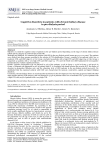
Cognitive disorders in patients with chronic kidney disease in pre-dialysis period
Статья научная
Objective: to study the cognitive status of patients in the pre-dialysis period depending on the stage of chronic kidney disease (CKD) and the category of cardiovascular risk (CVR). Materials and Methods. We examined 98 patients with CKD in the pre-dialysis period (mean age 47.1±11.2 years). The patients were divided into three groups according to the criteria of CVR stratification. Group 1 consisted of 32 patients with a low or moderate CVR, and CKD stage C1 or C2; Group 2 included 34 patients with a high CVR and CKD stage C3a or C3b; Group 3 comprised 32 patients with a very high CVR and CKD stage C4. We used the SAGE test (Self-Administered Gerocognitive Examination) to evaluate cognitive functions. Results. Cognitive impairment (CI) was detected in 57% of the patients: 37.5% in Group 1, 44.1% in Group 2, and 90.5% in Group 3. Dementia was diagnosed in 19% of patients with CI. A correlation was found between the severity of CI, the degree of decrease in glomerular filtration rate, and the education level of CKD patients in the pre-dialysis period (p≤0.001). We established that the examined subjects with CKD were characterized by memory, constructive, spatial and logical thinking disorders. Conclusion. Chronic kidney disease is an independent risk factor for the development of CI. The latter progressed with both CKD stage and the patient’s CVR category, and was detected in 37.5% of patients with a low or moderate CVR, 44.1% of patients with a high CVR, and 90.5% of patients with a very high CVR.
Бесплатно
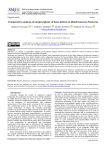
Comparative analysis of surgical plasty of bone defects in distal humerus fractures
Статья научная
Objective: to conduct a comparative analysis of the plastic surgery outcomes of bone defects in various locations in distal humerus fractures using block and cancellous allografts. Materials and methods. The study included 56 patients with comminuted fractures of the distal humerus distributed among 3 groups depending on the bone defect location and 2 subgroups based on the bone grafting. Elbow joint function was assessed using the Broberg and Morrey rating system, pain syndrome was evaluated according to the visual analog scale. Results. The amplitude of flexion and extension movements of the elbow joint in medial area defects 1.5 months after plastic surgery with a block allograft reached 90±5º (p=0.04) and 75±6º when using cancellous allograft. Three months after surgical repair with a block allograft, the strength and pain scores for defects reached 80±2 pts in the central area, 82±3 pts in the lateral area and 88±4 pts in the medial column. For cancellous allograft, these scores were 59±5 pts (p=0.01), 62±3 pts (p=0.01) and 60±3 pts (p=0.03), respectively. Conclusion. The plasty of the bone defect with a block allograft for distal humerus fractures contributes to an increase in the multiplanar range of motion 1.5 months after surgery for a medial column defect, and also improves strength and increases range of the flexion and extension motion, and reduces pain 3 months after surgery for defects of the medial, lateral and central metaphyseal locations.
Бесплатно
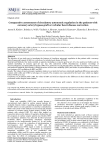
Статья научная
The objective of our study was to investigate the features of circulatory autonomic regulation in the patients with a coronary artery bypass graft surgery (CABG) or correction of a valvular heart disease (CVHD). Material and Methods. Our study enrolled 42 patients (including 12 women) aged 63 (57; 67), who underwent CABG; and 36 patients (including 16 women) aged 58 (47; 65), who underwent CVHD. Simultaneous 15-minute recordings of electrocardiograms and photoplethysmograms (PPG) were performed on all patients before and after the surgery. We assessed and analyzed statistical and frequency-related measures of heart rate variability (HRV) and index of synchronization (S) among low-frequency (LF) oscillations in HRV and PPG. Results. The values of most autonomic regulation indices in our study did not have statistically significant differences among the patients with CABG and CVHD at all stages of research. The exception was represented by the heart rate, which was higher before CVHD (p=0.013). Conclusion. In all patients with CABG, the values of HRV and S did not depend on the differences in their clinical statuses or performed cardiac surgical interventions.
Бесплатно
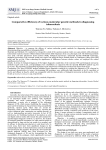
Comparative efficiency of various molecular genetic methods in diagnosing tuberculosis
Статья научная
Objective – to compare the efficacy of various molecular genetic methods for diagnosing tuberculosis and determining drug susceptibility to rifampicin (RIF). Materials and Methods. We conducted a retrospective study of the sputum analysis results on 1,992 patients with pulmonary tuberculosis treated at Saratov Oblast Clinical Tuberculosis (TB) Dispensary from 2014 through 2018. The following methods were used: real-time polymerase chain reaction (PCR), biological microarrays, automated Xpert® MTB/RIF technology. Statistical processing of the research results was carried out using the Bayes formula based on contingency tables (four-field table) and the χ2 test. When evaluating the significance of differences between relative values, we employed the critical significance level of 0.05. Results. In terms of etiological diagnosis of TB, higher diagnostic sensitivities of the real-time PCR and biological microarray methods (73.9% and 70.3%, correspondingly) were established, as compared with the Xpert® MTB/RIF method (34.2%) (p<0.001). The sensitivity of all methods depended on the massiveness of bacterial excretion and clinical form of TB. Conclusions: The Xpert MTB/RIF method exhibited lower diagnostic sensitivity in verifying the diagnosis of TB, whereas its operational characteristics in terms of determining RIF-resistance were sufficiently high (sensitivity at 89.7%, specificity at 89.1%, and efficacy at 89.4%), which was comparable with the characteristics of biological microarray method (93.9%, 71.8%, 82.9%; p=0.127, p<0.001, p=0.139, respectively).
Бесплатно
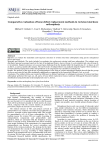
Comparative evaluation of bone defect replacement methods in revision total knee arthroplasty
Статья научная
Objective: to evaluate the immediate and long-term outcomes of revision total knee arthroplasty using porous metaphyseal sleeves and cones. Materials and Methods. The study included 134 patients who underwent revision total knee arthroplasty. The patients were distributed among two groups based on the type of metaphyseal fixator: sleeves (Group I, n=97 patients) and cones (Group II, n=37 patients). Surgical outcomes were assessed upon discharge from the hospital (after the hospital stay of 7-12 days), as well as after 6, 12 and 24 months after surgery. The survival rate of endoprostheses was analyzed using the Kaplan–Meier method. A revision with total replacement of the endoprosthesis or its components was considered a critical event. Results. The analysis of the survival rate of endoprostheses in the form of various metaphyseal fixators showed that the groups of sleeves and cones did not differ statistically significantly as suggested by the logrank test (Mantel–Cox): p=0.108. Conclusion. The midterm follow-up revealed no difference in clinical, functional, or radiological outcomes of revision total knee arthroplasty performed for types 2A, 2B, and 3 of bone defect replacement (sensu Anderson Orthopaedic Research Institute classification) using trabecular metal metaphyseal cones vs. sleeves.
Бесплатно
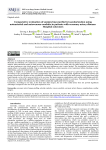
Статья научная
Objective: to evaluate the hospital outcomes of coronary artery bypass grafting using autoarterial and autovenous conduits. Materials and Methods. We conducted a randomized clinical trial. We used the left internal thoracic artery for bypassing the anterior interventricular branch in both groups. The remaining conduits were either only the radial artery or the radial artery and great saphenous vein (study group) or solely the great saphenous vein (control group). The investigated outcomes were, among others, in-hospital mortality, Type 5 myocardial infarction, cerebrovascular event, respiratory failure, bleeding, cardiac arrhythmias, and acute kidney injury (AKI). Results. A sample of 27 patients was randomly distributed among the study group (n=12) and the control group (n=15). According to the perioperative and early postoperative data, there were no statistically significant differences between the groups, except for the duration of stay on artificial ventilation in intensive care unit: in the study group, it was longer than in the control group: 14 (12; 18) h versus 9.3 (5.8; 13) h, p=0.034. The most common complications were cardiac arrhythmias and AKI. There were no statistically significant differences between groups regarding studied for outcomes. Postoperative hospital stay (expressed as number of bed days) also did not differ statistically significantly between groups. Conclusion. According to our data, in the first days after surgery, the use of the radial artery does not provide significant advantages compared to the use of the great saphenous vein.
Бесплатно
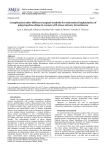
Статья научная
Objective: to identify the proportion of complications after suburethral implantation of polypropylene slings in women with stress urinary incontinence based on a seven-year experience. Material and Methods. We conducted the analysis of а seven-year experience in various implantation techniques of suburethral slings in 1260 women with stress urinary incontinence: inside-out and outside-in obturator sling fixation; suprapubic sling fixation and non-trocar mini-sling installment. Results. The highest incidence of complications was observed over the first two years after suburethral sling implantation was performed. Subsequently, the proportion of complications declined progressively to the lower limit values of 7-8% in the course of three last years. An incidence of early surgical complications among various suburethral sling implantation techniques had no statistically significant differences. However, after the suprapubic sling implantation, intraoperative and mesh-associated complications prevailed. Conclusion. Our study confirmed that suburethral sling implantation using suprapubic fixation method was associated with a higher incidence of complications and should have been performed exclusively for the target group of the patients, for whom safer surgical procedures were contraindicated.
Бесплатно
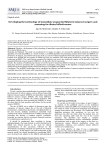
Статья научная
Objective: development of the technology of immediate sequential bilateral cataract surgery (ISВCS) and assessment of its clinical effectiveness. Materials and Methods. Our study was conducted in two stages. At stage I, we reviewed the published materials on traditional algorithm of conducting ISВCS, as a result of which, a modified algorithm for performing surgical intervention (mоISBCS) was developed. At stage II, 130 patients (mean age of 58.4±1.8 years) with uncomplicated binocular cataract were under observation. Patients were divided into two groups of similar age and eye condition. The main group included 67 people (134 eyes), who underwent mоISBCS. The control group comprised 63 subjects (126 eyes), who underwent surgery on the second eye (delayed sequential bilateral cataract surgery, DSВCS) 21–28 days after the first operation. Results. The analysis of traditional provisions served the basis for improving ISВCS technology by including a long (at least 60 min) pause between operations with a comprehensive examination of the patient in the algorithm of surgical intervention. The obtained data demonstrated similar clinical effectiveness of mоISBCS and DSВCS. Conclusion. The mоISBCS technology can be considered an effective and safe method of cataract surgical treatment, which is especially important for patients with occupation yielding a visual stress.
Бесплатно
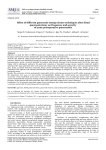
Статья научная
Objective: to study the effect of different pancreatic stump closure techniques and diameter of the main pancreatic duct on frequency and severity of acute postoperative pancreatitis after distal pancreatectomy. Material and Methods. Distal pancreatectomy was performed on 126 patients with neoplasms of body and/or tail of the pancreas. Patients were distributed among four groups based upon the pancreatic stump closure technique applied after distal pancreatectomy: group 1 (control) included the patients with isolated suturing of the main pancreatic duct in the pancreatic stump with its subsequent sealing by the gastrocolic omentum or hemostatic sponge; group 2 patients underwent isolated suturing of the main pancreatic duct in the pancreatic stump with its subsequent sealing with 2-octyl cyanoacrylate biological glue; group 3 patients had their pancreatic stump closure performed with endoscopic linear cutter stapler; group 4 was composed of the patients with external transduodenal transnasal drainage of enlarged (D>3 mm) main pancreatic duct in the pancreatic stump. Results. The occurrence of acute postoperative pancreatitis in the control group amounted to 45.8%, while, in groups 2, 3 and 4, the frequencies were 44.4, 9.7 and 15.0(%), correspondingly. Besides, the control group was characterized by declined occurrence of the moderately severe form of acute postoperative pancreatitis. Use of endoscopic linear cutter stapler and external transduodenal transnasal drainage of the enlarged main pancreatic duct caused lower acute postoperative pancreatitis frequency in the patients with main pancreatic duct in their pancreatic stumps below 5 mm in diameter. Conclusion. Use of proposed pancreatic stump closure techniques after distal pancreatectomy resulted in lower frequencies of occurrence and severity of acute postoperative pancreatitis.
Бесплатно
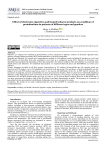
Статья научная
Objective: to compare the condition of periodontium in three categories of patients: smokers of electronic cigarettes (EC), smokers of heated tobacco products (HTP) and nonsmokers vs, their age and gender. Materials and Methods. We carried out a comprehensive analysis of 1,754 patient records including EC smokers (n=1,122) and HTP smokers (n=632).Data from 566 nonsmokers were used as a comparison group (CG). Patients of all groups were distributed among subgroups depending on their age and gender. The clinical condition of the periodontium was assessed using dental indices and indicators. For statistical data analysis, we employed Microsoft Excel and STATISTICA 64 version 20.0 software. Results. Gingivitis prevailed in all three groups. Itsprevalence in EC smokers decreasedwith age; the opposite trend was observed in HTP smokers. As for CG, gingivitis was recorded in all age groups. The prevalence of acute periodontitis was the highest in EС and HTP smokers aged 35-39 years vs. 30–34-year-old individuals of the CG. In HTP and EC smokers, the prevalence of gingivitis and acute periodontitis was more pronounced in females, while we observed no statistically significant difference of the kind between men and women of the CG. The frequency of occurrence of localized chronic periodontitis was maximum in EC and HTP smokers at the age of 40–44 years vs. 45–50 years in the CG subjects. However, in the HTPGroup, it was more pronounced in females, while in the EC Group it was more characteristic in males. The frequency of occurrence of generalized chronic periodontitis in individuals of all groups was more pronounced in women. Conclusion. The results of our study confirmed that the use of EC and HTP is a harmful factor causing the occurrence of periodontal disease.
Бесплатно
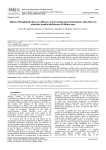
Статья научная
The objective was to study the dose-dependent effects of glucagon-like peptide-1 receptor agonist, liraglutide, on microcirculation in white rats under the alloxan-induced insulin deficiency. Materials and Methods. Our study was carried out on 70 white rats, divided into four groups: 20 intact control animals; 20 animals of the comparison group with alloxan-induced diabetes; 10 animals with insulin deficiency, injected with liraglutide at a dose of 0.2 mg/kg per day (treatment group No. 1); and 20 animals with insulin deficiency treated with liraglutide at a dose of 0.4 mg/kg per day (treatment group No. 2). Diabetic status, skin perfusion of the posterior limb and mechanisms of blood flow modulation were assessed in all groups of animals. Results. It was established that administering liraglutide at a dose of 0.4 mg/kg per day allowed achieving complete normalization of carbohydrate metabolism in rats with alloxan-induced insulin deficiency, thereby more effectively improving the state of microcirculation, compared with a dose of 0.2 mg/kg per day. Conclusion. The efficacy of correcting the microcirculatory disorders with liraglutide correlates with correcting the carbohydrate metabolism in rats with insulin deficiency and depends on liraglutide dose. The dose-dependent effect is achieved by the endothelial mechanism of flow modulation in microcirculation. However, the restoration of the vascular tone neurogenic component is independent of liraglutide dose.
Бесплатно
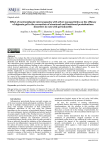
Статья научная
Objective: To evaluate the effect of metronidazole loaded into alginate microcapsules impregnated with silver on structural and functional periodontium disorders in periodontitis. Materials and Methods. Our research was conducted on 30 white male rats, randomly distributed among two groups. The comparison group consisted of 15 animals with experimental periodontitis, which received applications of a gel containing microcapsules without additional loading of active substances. The experimental group included 15 animals with periodontitis, which received applications of gel with microcapsules containing metronidazole to the inflamed gums. To assess the morphological changes in periodontium, the mandible was collected followed by its histological examination. Results. Application of a gel containing microcapsules with silver nanoparticles loaded with metronidazole on the gums of animals with periodontitis led to a partial reduction of structural disorders. E.g., out of 15 animals, local disorganization of the periodontal ligament fibers in the experimental group was observed only in 5 cases and signs of limited bone loss were observed in 2 cases. In the comparison group, bone resorption was noted in all 15 animals, while diffuse alteration of fibers throughout the periodontal ligament was confirmed in 13 of 15 cases. Conclusion.The inclusion of metronidazole in alginate microcapsules with silver nanoparticles leads to a significant reduction in the destructive processes occurring in the periodontal tissues during periodontitis.
Бесплатно
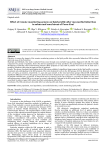
Статья научная
Objective: to assess the impact of the remote monitoring system on the lipid profile after myocardial infarction (MI) in urban and rural areas of the Perm Krai. Materials and Methods. Our study conducted from 2020 through 2022 included 253 patients diagnosed with MI. The study compared two groups of patients: those who did not participate (n=105) and those who participated in the Remote Health Monitoring of Patients with Cardiovascular Diseases (RM) program (n=148). RM of patients was carried out at least once a month by telephone calls using an approved list of questions. Results. The group of patients participating in the RM system exhibited a significant improvement in the lipid profile vs. groups of patients not participating in the RM program. The total cholesterol levels in the RM groups of Perm Krai and city of Perm were 3.77 and 4.30 mmol/L, respectively, vs. 5.50 and 4.50 mmol/L in the rural and urban groups without RM. Statistically significant differences between the groups were observed only in Perm Krai (p=0.002). The low-density lipoprotein (LDL) level in patients with RM was 1.77 mmol/L in Perm Krai and 2.31 mmol/L in the city of Perm vs. 3.24 and 2.67 mmol/L in the rural and urban groups without RM (p=0.049 and p=0.025), respectively). Patients in the RM group from Perm Krai were 15.6 times more likely to achieve target LDL values than their counterparts without RM. Conclusion. The RM system had a favorable effect on reducing LDL and cholesterol in both urban and rural groups of residents.
Бесплатно
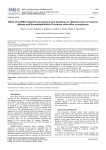
Статья научная
Objective: to analyze the features of clinical course of lower limb varicose vein disease and acute thrombophlebitis of varicose veins for the patients with undifferentiated connective tissue dysplasia (UCTD) after crossectomy. Materials and Methods. The prospective clinical cohort study involved 132 female patients with varicose disease who underwent crossectomy, of which 67 patients with dysplasia were included into the main group, whereas patients without dysplasia were included into the control group. Examination of patients and ultrasound scanning of leg veins were conducted in 3, 6, 12, and 36 months. The Cox regression analysis was used to assess the effect of dysplasia on the risk of developing thrombophlebitis of varicose veins. Results. The progress of varicose disease clinical manifestations of after crossectomy was detected in 57 (85.1%) female patients with dysplasia and in 14 (21.5%) without it (р=0.002), which resulted in phlebectomy. The recurrent thrombophlebitis of varicose veins was found in 22 (32.8%) female patients with dysplasia vs. 5 (7.7%) without it (р=0.002). Cox regression model Exp (B), which characterizes the predicted change of risks for dysplasia, was 4.216 (95% CI 1.595-11.147). Conclusion. The clinical course of varicose disease in patients with UCTD is characterized by the progression of clinical manifestations of chronic venous insufficiency of a lower limb. UCTD results in over 4.2-fold risk of developing the recurrent thrombophlebitis of varicose veins after crossectomy.
Бесплатно
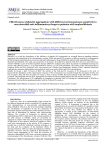
Статья научная
Objective: to reveal the dependence of the efficiency of platelet (PL) aggregation on crosstalk between signaling pathways associated with stimulation of the thromboxane receptor (TxR) and purine P2 receptors at different activity of cyclooxygenase (COX) during the administration of non-steroidal anti-inflammatory drugs (NSAIDs) in patients with nephrolithiasis (NLT). Materials and Methods. Our study was prospective in its nature. It included 60 patients with NLT who were prescribed non-selective NSAIDs as part of medical expulsive therapy (MET) for analgesia. The cohort of patients was distributed among two groups: with effective (Group 1, n=30) and ineffective (Group 2, n=30) COX inhibition. The activity of the TxR and purine P2 receptors (P2X1 and P2Y receptors) of PL was assessed on a Chrono-Log Hematology Analyzer (USA). Agonists (adenosine triphosphate, adenosine diphosphate and arachidonic acid) were used at EC50 and EC10 concentrations. Results. In Group 1, after 72 hours of MET, the activity of the TxR and P2 receptors of PL decreased to the level of hyporeactivity. Regulation of the compensatory response of PL to hematuria was ensured through the synergism of P2X1 and P2Y receptors, TxR, and P2X1 receptors. In Group 2, after 72 hours of MET, the hyperreactivity of the TxR and P2 receptors persisted. The maximum increase in PL aggregation was achieved with synergism between the TxR and P2Y receptors. Conclusion. The effectiveness of PL aggregation in hematuria of patients with NLT during the administration of NSAIDs is determined by intracellular signaling associated with the TxR and P2 receptors.
Бесплатно
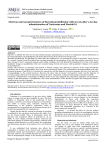
Статья научная
Objective: to identify the effect of a 60-day isolated tartrazine administration, as well as in combination with the Mexidol ®, on the structural features of parafollicular cells in the thyroid of rats at the electron microscope level. Materials and Methods. We distributed 30 white male rats weighing 200–210 g among five groups of equal sizes. Group I served as a control. Groups II and III included rats receiving tartrazine at concentrations of 750 and 1,500 mg/kg, respectively, for 60 days. Groups IV and V comprised animals under similar conditions, but with Mexidol ® administered at a dose of 50 mg/kg. Qualitative changes in parafollicular cells were examined using electron microscopy, while quantitative changes were assessed via morphometry. Results. After exposure to tartrazine, fine-grained or fibrous contents were detected in cisternae of the rough endoplasmic reticulum, and in some mitochondria, there were areas of destroyed matrix. The euchromatin to heterochromatin areas ratio decreased in groups II and III by 5.7% and 56.9%, respectively, and the diameter of secretory granules did so by 12.3% and 19%, correspondingly, vs. the control (Group I). However, the above ratio in Group V increased by 79.6%, and the diameter of secretory granules did so by 8.2% and 6.5% in Groups IV and V, respectively, compared with animals of Groups II and III. Conclusion. Administration of tartrazine in different doses for 60 days triggered dose-dependent qualitative and quantitative changes in the ultrastructure of parafollicular cells, while administration of the Mexidol ® against this background caused a reduction in the severity of changes.
Бесплатно
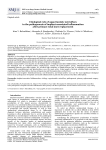
Статья научная
Objective: to investigate etiological role of opportunistic microflora in the pathogenesis of implant-associated inflammation in patients after primary knee replacement and antibiotic resistance of major infectious agent groups. Material and Methods. We conducted the retrospective analysis of microbiological samples from 383 patients with postoperative implant-associated inflammation after the primary total knee arthroplasty. Results. Gram-positive cocci (63.5%) are the leading agents of implant-associated inflammation. We also noted an increase in the etiological role of coagulase-positive staphylococci. Among the Gram-negative group, Enterobacteriaceae and non-fermenting bacteria were major agents. We revealed high resistance of Staphylococcus spp. to antibiotics of various groups, among which oxazolidinones and glycylcyclines were the most active. Gram-negative bacteria exhibited high resistance to cephalosporine and macrolides, whereas carbapenems and fluoroquinolones worked best. Conclusion. Gram-negative Enterobacteriaceae, non-fermenters, and Gram-positive cocci are the most significant etiological factors in the pathogenesis of implant-associated inflammation in patients after primary total knee arthroplasty.
Бесплатно
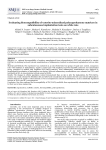
Статья научная
Objective: to estimate biocompatibility of matrices manufactured from polycaprolactone (PCL) and mineralized by vaterite (CaCO3) via studying local and systemic manifestations of inflammatory reaction in subcutaneous implantation tests on white rats. Material and Methods. The experiment was conducted on 40 rats divided into four groups of equal sizes: control, comparison (rats with imitation of implantation), negative control (rats with implanted non-biocompatible matrices) and experimental group, comprised of animals with implanted PCL/CaCO3-matrices. Local inflammatory manifestations were analyzed by morphological investigation of implantation area tissues. Systemic inflammatory manifestations were estimated via TNF-α and interleukin-1β (IL-1) concentrations in blood serum by ELISA. Results. The changes in cellular population content demonstrated that, on day 21 after the implantation, the PCL/CaCO3-matrice was evenly colonized by fibroblast cells and afterwards vascularized. Such matrices did not cause intense inflammatory reaction observed in negative control animals. It was accompanied by systemic manifestations, such as statistically significant increase in TNF-α and IL-1 concentrations. Conclusion. Our data confirmed the biocompatibility of PLC/CaCO3-scaffolds, thus experimentally substantiating the potential for their use in tissue engineering.
Бесплатно
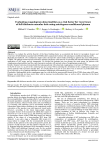
Статья научная
Objective: to evaluate the activity disorder of the blood clotting factor as a potential risk factor for incomplete closure and recurrence of full-thickness macular holes (FTMHs) after surgical intervention with autologous conditioned plasma (ACP). Materials and methods. We conducted a single-center retrospective cohort study involving 62 patients (62 eyes) with primary FTMHs. The patients underwent microinvasive subtotal vitrectomy with removal of epiretinal and internal limiting membranes, application of ACP mass, and air tamponade. We divided the patients into two groups: the main group (31 patients with coagulogram abnormalities) and the control group (31 patients with normal values of coagulogram parameters). Results. Surgical outcomes demonstrated that among patients with abnormal coagulogram, recurrence of FTMH was observed in 85.7% of cases vs. 14.3% in the control group (p=0.005). When assessing the deviations in the coagulogram parameters among patients with recurrent macular hole, we revealed that in 83.3% of cases there was an increase in prothrombin time (p=0.042) and 75.0% of patients exhibited a reduction in fibrinogen concentration (p=0.049). Conclusion. Abnormalities in the coagulogram may be a risk factor for unsuccessful closure of the FTMH when using ACP mass. Relapse was detected six times more often with an increase in prothrombin time, as well as with a reduction in the blood fibrinogen content below 2.0 g/L.
Бесплатно
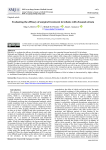
Evaluating the efficacy of surgical treatment in infants with choanal atresia
Статья научная
Objective: to evaluate the efficacy of stentless endoscopic surgery for congenital choanal atresia (CCA) in infants. Materials and Methods. Our study involved 51 infants under 1 year of age who underwent stentless choanoplasty. Main group: infants operated for the first time (n=27). Comparison group: infants with relapse after traditional choanoplasty with stents (n=24). Endoscopic examination and saturation levels were employed to evaluate treatment results. Quality of life was assessed using la Qualité de Vie du Nourrisson questionnaire for children from 3 months of age to 1-3 years of age. Parents of 45 infants participated in the survey: 25 infants were from the main group and 20 infants represented the comparison group. Results. No signs of restenosis were detected during endoscopic examination of the nasal cavity and nasopharynx in 50 patients during follow-up observation (1-2 years). Saturation after surgery increased from 98.4±2.4% to 99.4±1.2% (p=0.001) in patients of the main group and from 93.5±4.7% to 99.0±1.0% (p<0.001) in the comparison group. Assessment of quality-of-life values after surgical treatment by the stentless method showed an increase from 14.4±0.4 to 15.3±1.8 (p=0.056) in the main group and from 14.0±0.4 pts to 15.6±1.0 pts (p<0.001) in the comparison group. Conclusion. Endoscopic endonasal stentless method of surgical treatment of CCA in infants is characterized by higher efficacy vs. traditional choanoplasty with stenting.
Бесплатно

